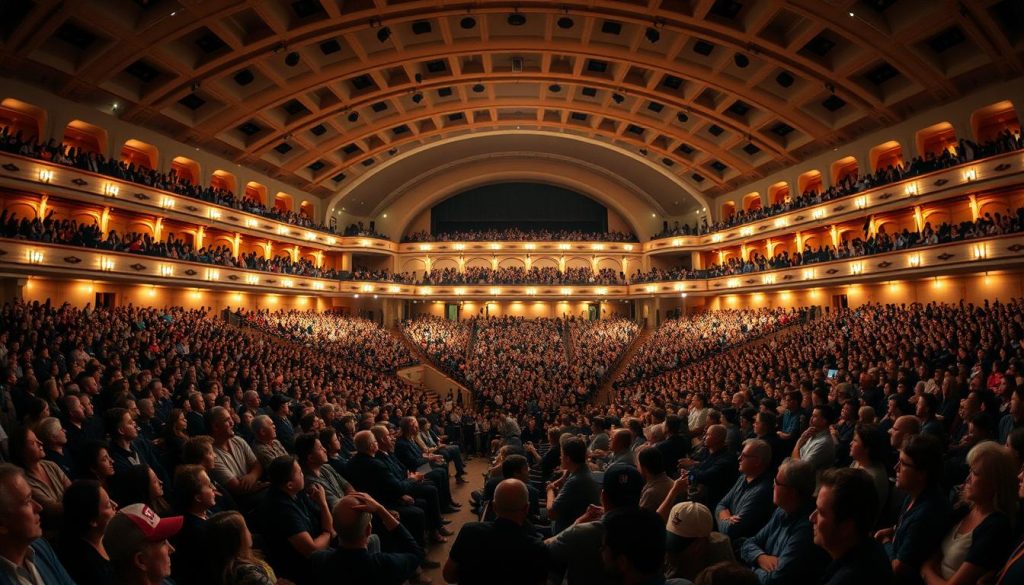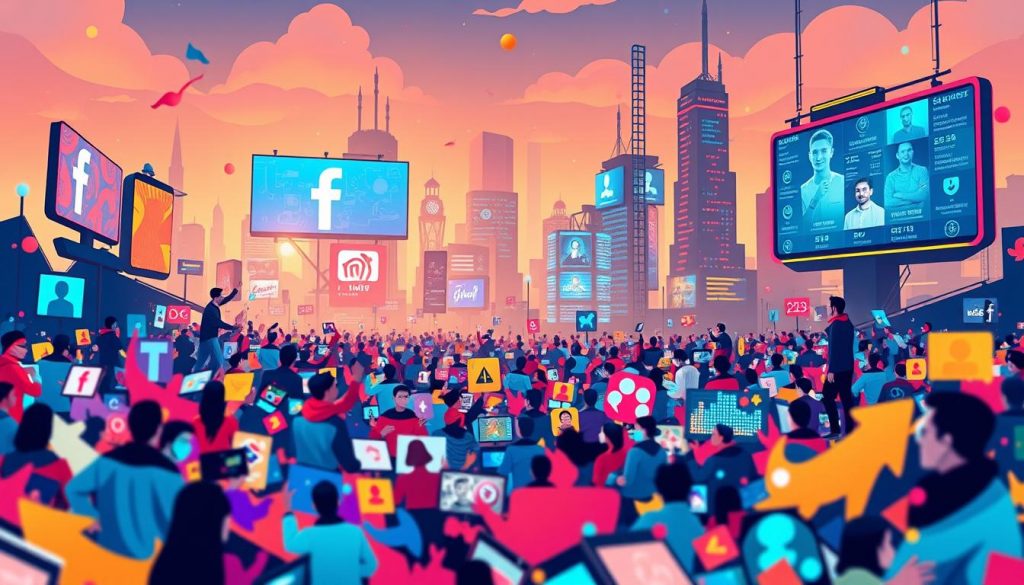We set the stage for how you convert attention into measurable results on a massive platform. With 3.35 billion daily active users and Meta reporting $164.50B in revenue, scale is real. We focus on the data that matters.
Here, you’ll learn how engagement and conversion metrics shape audience strategy. Reels, feed, and image engagement rates differ; CTRs and CPCs vary by objective. We translate those benchmarks into practical choices.
Our goal is to show why this channel can deliver high ROI when you prioritize the right content, ads, and video formats. We explain which KPIs matter at each funnel stage and how to tie them to leads, purchases, and lifetime value.
Finally, we preview the algorithm and creative shifts that affect discovery and delivery. This introduction maps the path so you can jump to sections that match your priorities—audience growth, proof of impact, or budget allocation.
Key Takeaways
- Scale and performance data set realistic goals; use benchmarks to plan outcomes.
- Prioritize short video and narrative-led sequences to lift engagement.
- Track the right KPIs by funnel stage to connect activity to revenue.
- Test ads and content rapidly; agile learning beats slow hypotheses.
- Use data-driven targeting to lower cost per lead and improve conversion.
- Align budgets to formats and audiences that show measurable results.
Why Facebook Still Dominates in 2025
When a platform reaches billions, predictable audience access becomes a strategic asset. We see clear signals: scale, steady revenue, and behavior that favors discovery and commerce. That mix gives you room to plan campaigns that move people through the funnel.
3.35B daily active people and $164.5B revenue: what the scale means for marketers
Scale equals stability. With 3.35B daily active people and $164.5B in revenue, the platform supports reliable reach and efficient acquisition. That stability helps brands forecast outcomes and invest in creative that drives conversion.

Audience isn’t just older: 43% under 35 and growing multi-generational reach
About 43% of users are under 35, while older segments have doubled since 2012. This multi-generational audience lets you run full-funnel work without sacrificing younger cohorts.
“Video drives discovery—78% of consumers report finding new products via video, and pages under 10,000 likes often see higher engagement than large pages.”
- Social commerce lowers friction: buyers can move from interest to purchase faster.
- Video-first behavior favors short, engaging clips over link posts.
- Smaller pages can punch above their weight, improving outcomes for SMBs.
We recommend aligning content to user behavior and algorithmic delivery so your posts meet people where they spend attention.
Facebook Marketing Trends 2025: The Big Picture
A mood-led content cycle is replacing fast meme-chasing and reshaping how brands plan creative. This shift favors sustained emotional signals over one-off viral pushes.

We see two clear outcomes: social teams must experiment more, and agile strategy wins.
From vibe-driven culture to agile strategies: how trend cycles are changing
Vibe-driven culture asks you to build creative that lasts. Teams plan sequences that keep a mood across posts and pages.
“Sustained creative moments beat short-lived trend-hopping for long-term reach and recall.”
Benchmarks to watch: engagement rates, CTR, CPC, CPA, conversion rates
Use benchmarks as guardrails. Reels average ~0.22% engagement; feed sits near 0.07%. CTRs and CPCs vary by objective.
| Metric | Traffic | Lead Gen | Conversion (avg / sample) |
|---|---|---|---|
| CTR | 1.57% | 2.53% | — |
| CPC | $0.77 | $1.88 | — |
| Conversion Rate | — | — | Avg 9.21% (fitness 14.29%, edu 13.58%, tech 2.31%) |
- Plan weekly: adapt creative and media to performance signals.
- Test formats aligned to native features and the video-first algorithm.
- Document hypotheses, define thresholds, and pivot only on clear data.
Algorithm, Attention, and Engagement Shifts You Need to Track
Algorithm changes are shifting value to short, high-intent video that hooks fast. We see the delivery system favoring placements that keep users on-platform. That means Reels and Stories matter more for reach and watch time.
Video-first feed: Reels and Stories elevated by the algorithm
The algorithm increasingly privileges vertical, sound-on video. Strong openers and native pacing win distribution. Creators who front-load value in the first two seconds earn more impressions.
Engagement realities: feed vs Reels
Plan with realistic engagement rates. Reels average ~0.22% while feed sits near ~0.07% (images ~0.12%).
- Hook fast: openers, clear captions, and native pacing drive higher watch time.
- Design for completion: replays, shares, and saves boost algorithmic delivery.
- Pair creative with media: placement-optimized cuts outperform one-size-fits-all assets.
- Ads need next steps: one idea per clip and a concise CTA convert attention into action.
We continuously test topic, hook style, length, and captions to protect delivery and sustain higher engagement over time.
Creative That Wins: Formats, Specs, and Storytelling for Higher Engagement
Start with placement-first creative: design for where users stop, watch, and act. We choose the canvas, pacing, and copy to match attention windows. This reduces rework and lifts completion rates.
Short-form video and Reels
Reels perform when hooks are bold. Use 9:16, front-load value in the first two seconds, and add on-screen text since automated captions may fail. Keep edits tight and use clear CTAs to drive action.
Stories, In-Stream, Feeds, Search, and Explore
Stories work best for immediacy: 9:16 up to two minutes, split into 15s cards. Avoid the top and bottom 250px for logos and critical text.
In-Stream suits demos or slightly longer narrative; plan 5–15s cuts for desktop and longer mobile edits. Feed and Video Feeds favor 1:1 or 4:5 with strong thumbnails and captions for sound-off viewing.
Search Results and Business Explore pair well with intent-based creative; use 1:1 or 4:5 to match discovery behavior and speed users toward action.
Carousels and Collections
Carousels and collections become guided experiences. Frame a sequence that educates, answers objections, and ends with a shoppable step. These formats turn features into clear buying paths.
“Link posts see far less engagement than native video; designing for native behavior improves reach and conversion.”
- Design rule: native specs first—avoid repurposed edits.
- Safe zones: preserve 250px top/bottom in Stories for UI clarity.
- Production: document specs and checklists to speed output and keep the brand consistent.
| Placement | Aspect Ratio | Typical Length | Best Use |
|---|---|---|---|
| Reels | 9:16 | Short, no strict limit | Discovery, high completion |
| Stories | 9:16 | Up to 2 min (15s cards) | Immediacy, CTAs |
| Feed / Video Feeds | 1:1 or 4:5 | 10–60s | Thumbnails, sound-off viewers |
| In-Stream | 16:9 or 1:1 | 5–15s (desktop) / up to 10 min (mobile) | Demos and longer storytelling |
Targeting in a Privacy-First Era: First-Party Data, Broad Targeting, and AI
As privacy rules tighten, first-party data becomes the backbone of efficient audience reach. We build custom audiences from recent behavior and frequency to keep budgets focused on the users most likely to act.
Custom audiences and recency-frequency-behavior segmentation
We prioritize recency, frequency, and specific actions—cart abandons, product views, repeat visits. These segments convert better than generic lists.
Short windows power urgency. Longer windows help retention messages. We separate tiers so each audience sees the right creative and CTA.
Lookalike limitations and when broad targeting wins
Post iOS14+, strict device-level signals reduced lookalike accuracy. Many advertisers now run broader target sets and let the platform’s algorithm optimize delivery.
We test clear conversion goals with broad audiences to let AI find incremental users while tracking lift by cohort.
Advantage+ Sales Campaigns: automation trade-offs and creative implications
Advantage+ campaigns trade manual controls for scale. They often improve performance but demand cleaner conversion signals and diverse creative sets.
Our play: feed the tool many variants, keep conversion events accurate, and refresh content to avoid fatigue.
- Tier campaigns: prospecting, retargeting, retention—match message to journey.
- Use geo-behavioral layers for local offers while keeping scale.
- Implement server-side events and the Pixel to stabilize algorithm learning.
| Focus | Primary Signal | Best Use |
|---|---|---|
| Custom Audiences | First-party behavior (recency / frequency) | Retargeting, upsell, cart recovery |
| Broad Targeting | Platform algorithm + conversion goals | Prospecting at scale |
| Advantage+ Sales | Automated bidding + creative variants | Simplified operations, creative-first strategy |
Social Listening Becomes Performance: From Insights to Revenue
Listening to real-time conversations gives teams a direct route from signals to measurable revenue. Sixty-two percent of social marketers now use listening tools, and many organizations rank listening as a top social priority.
We turn those signals into action. Listening informs creative briefs, media buys, and community replies so content lands with the right audiences at the right time.
How listening elevates ROI confidence and budget credibility
Listening reduces guesswork. It shows what topics gain momentum and which messages drive engagement.
This builds budget credibility. When we can point to data and clear impact, stakeholders fund more tests and scale winners faster.
Micro-virality over mass-virality: timing, fit, and cultural alignment
We chase micro-virality — small, audience-relevant moments that match brand fit. These wins are timely and often more profitable than broad viral pushes.
- Track topic momentum and sentiment to enter or exit conversations.
- Convert listening into briefs with angle, hook, and CTA for media scaling.
- Use tools to map creator threads and outbound engagement opportunities.
- Feed learnings back into targeting and content tests so performance compounds.
“Listening delivers real-time insights that improve strategy, uncover opportunities, prevent crises, and increase ROI confidence.”
Result: social becomes a revenue contributor — grounded in data, measured by outcomes, and trusted by marketers and decision-makers.
AI Moves From Tactics to Strategy
Generative intelligence is shifting from a tactical accelerator to a central part of our strategy. We now use AI to scale ideation, translation, and rapid variant testing without losing brand voice.
At scale, teams aim for 48–72 posts per week across channels. To hit that cadence, we pair human direction with AI-driven drafting and editing. This keeps content consistent and fast.
Generative AI at scale: content velocity, translation, and ideation
We use AI tools to draft scripts, generate localized copies, and create controlled variations. A prompt library and QA checklist keep outputs accurate and compliant.
AI as a thought partner: planning, forecasting, and executive summaries
AI also helps with planning scenarios and forecasting. It turns performance data into concise executive summaries so teams align faster and meet stakeholders with clear answers.
- Boost velocity: ideation, scripting, translation, and variant generation.
- Support strategy: scenario planning, forecasts, and concise summaries.
- Protect value: prompt governance, privacy safeguards, and IP rules.
“AI reduces bottlenecks and increases testing cycles, so ads and content improve on a shorter cadence.”
Performance Benchmarks to Set Expectations and Strategy
Begin with objective-driven benchmarks so your team can budget and test with confidence. We translate raw metrics into targets that match each campaign goal.
CTR, CPC, CPA by objective: traffic vs lead gen realities
Expect differences by objective. Traffic CTR averages 1.57% with a CPC near $0.77. Lead gen CTR sits higher at 2.53% while CPC rises to about $1.88.
| Objective | CTR | CPC |
|---|---|---|
| Traffic | 1.57% | $0.77 |
| Lead Gen | 2.53% | $1.88 |
Average conversion rates and industry variance to guide targets
Overall conversion rate averages 9.21%. Industry splits matter: fitness 14.29%, education 13.58%, tech 2.31%. Average CPL is roughly $21.98 but varies widely by category.
- Set targets by objective: align spend and pacing to CTR, CPC, and CPA expectations.
- Factor industry norms: judge performance against relevant benchmarks, not averages.
- Pair engagement rates and format: reels (~0.22%) often drive deeper funnels than feed (~0.07%).
We map these metrics to decisions so marketers can scale with confidence and protect reach while improving overall results.
Budgeting, Bidding, and Delivery: Getting More from Every Dollar
Budgeting choices shape delivery windows and determine which audiences we reach most often.
We align budget type to goal. For steady awareness we favor lifetime budgets to stabilize delivery. For direct response—leads and sales—daily budgets give agility and faster learning.
Daily vs lifetime budgets aligned to awareness, lead gen, and sales
Daily budgets let us react to performance quickly. Lifetime budgets smooth CPM and keep reach steady over longer flights.
Bid caps, target cost, and CPM: choosing by objective and stage
Bid strategy follows the funnel: CPM for exposure, target cost to balance volume and efficiency, and bid caps to hold CPA on conversion campaigns. We watch the algorithm closely and adjust bids when delivery drifts.
Dayparting and flighting: scheduling around peak engagement windows
Time spend to when users are most active. We daypart and flight around peak windows and promotional moments to cut wasted impressions.
- Refresh creative on delivery cycles to control frequency and keep content fresh.
- Use pacing rules to scale winners and trim underperformers in near real time.
- Set test allocations so learning continues without derailing core performance.
“With disciplined budgeting and bidding, your ads work harder and your next action is always clear.”
Placement Strategy and Media Mix: Reach, Relevance, and Results
Matching where you show up to why people are there makes every dollar work harder. We pick placements with intent in mind so content and media deliver measurable outcomes.
Feeds, Stories, In-Stream, Audience Network: matching goals to context
Feeds blend organic posts and paid ads for broad reach. They are ideal for awareness and brand moments.
Stories and short-form clips drive higher engagement. Use vertical edits, bold hooks, and short CTAs for quick impact.
In-Stream fits slightly longer narratives and commercial breaks. Reserve it for demos and benefit-led proof.
Audience Network extends reach outside the app for incremental scale. Treat it as a volume play with placement-aware assets.
Sequential storytelling: full-funnel journeys that convert
We build sequences that move users from discovery to purchase. Top-of-funnel impressions seed retargeting pools.
Later, benefit-rich creative and proof-driven ads reduce friction and speed conversions. The algorithm rewards cohesive journeys when each asset matches its stage.
- Match intent: feeds for reach, stories for higher engagement, in-stream for narrative.
- Optimize assets: length, aspect ratio, captions, and CTA placement vary by placement.
- Test sequences: find the mix that maximizes conversion without excess frequency.
“A coordinated media mix defends reach while focusing on attention-rich contexts that convert.”
Testing, Measurement, and Proving Impact
Controlled testing gives teams the confidence to scale what works. We build experiments that turn creative bets into clear results.
A/B and multivariate tests: variables that matter
We design tests around high-impact variables—headline, visual, CTA, and audience. Run controlled A/B or multivariate setups and let them reach statistical significance before calling winners.
- Minimum thresholds: 1,000+ impressions and 2+ days, adjusted by conversion volume.
- Include video and static variants; test captions and thumbnails for engagement.
- Document hypotheses so each post or creative on pages teaches the next iteration.
Meta Pixel, UTMs, and Offline Conversions: a complete data spine
We stitch first- and server-side signals together. Implement the Meta Pixel, server events, UTM parameters, and Offline Conversions to capture full-funnel information.
Lift tests and ROAS: isolating incremental impact
Lift tests show what your ads truly add. Marketers use them to calculate credible ROAS and make budget decisions with confidence.
- Run cohort or holdout tests to isolate campaign impact on users and revenue.
- Report on cost per result, conversion rate, and contribution to pipeline.
- Standardize documentation and dashboards so performance insights scale across content and audiences.
“With disciplined measurement, your facebook ads become a proven growth lever.”
Result: clearer information, repeatable wins, and faster improvements to creative, audience, and algorithm-driven delivery.
Conclusion
To close, focus on actions that turn engagement into measurable business value.
We recommend a short audit now. Check creative against placement specs. Refresh top hooks and align copy to audience time and behavior.
Next, connect first-party signals and server events so content feeds reliable learning. Schedule priority tests and document outcomes.
When you pair video-first content with listening and AI, your team gains speed and clearer proof of impact. That approach drives reach, lifts engagement, and grows lasting value.
Act quickly. Small changes compound into success and real business results for your brand and users.


